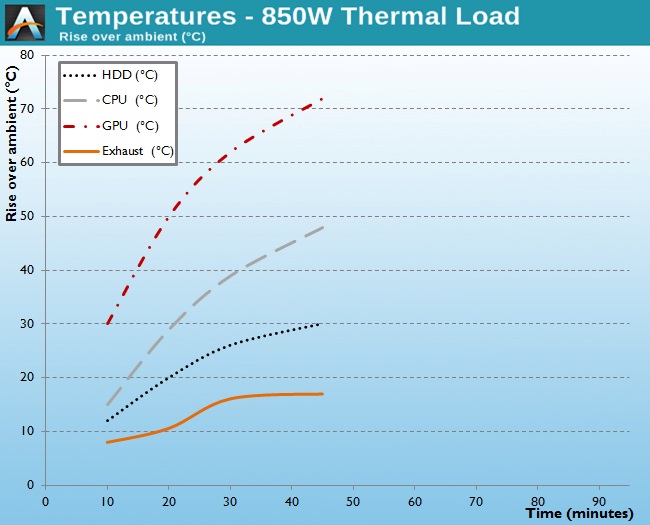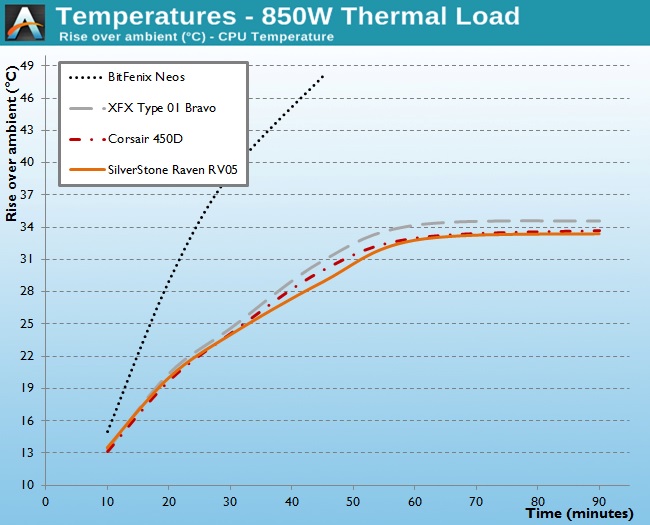BitFenix Neos Case Review
by E. Fylladitakis on January 21, 2015 9:00 AM EST- Posted in
- Cases/Cooling/PSUs
- bitfenix
- Case
Test Setup
Professional testing requires the emulation of real-world situations with repeatable results; thus, a perfectly controllable test setup and environment are required, especially for comparable results. Testing the thermal performance of any case with a typical real-world setup technically limits the comparability of the results to this setup alone, as an active system interacts with its environment and the change of a single component would alter myriads of variables.
To help alleviate such issues, we developed synthetic loads that emulate the thermal output of real systems, but these loads are passive, steady, and quantifiable. Our thermal testing now displays the thermal capabilities of the case alone, as if it would have to deal with the entire thermal load by itself, regardless of the system installed inside it. Laboratory data loggers are used to monitor the PT100 sensors and control the safety relays, which are fully accessible via our custom software.
Three such loads have been developed; the ATX version simulates a 200W CPU, 50W VRM, 30W RAM and 4 × 120W GPU card thermal load. Finally, three 3.5" HDD dummy loads have also been created, with each of them converting 30W of electrical power to thermal, bringing the total thermal load of the ATX test setup up to 850 Watts. This thermal load is immense and only the best of cases will be able to handle it for more than a few minutes; we are also performing a test with a thermal load of 400W, with all of the aforementioned components except the HDD drives at about 42% power, which is more suitable for the majority of cases.
Thermal testing is performed with the stock fan operating at maximum speed. Noise testing is performed with a background noise level of 30.4dB(A). Advanced noise testing is also performed, in order to assess the ability of the case to dampen the noise of the components installed inside it. This includes the installation of two noise-generating sources (strong fans) inside the case, one positioned approximately over the first expansion slot and one over the CPU area, which generate ≈ 44.2 dB(A) when unobstructed. During the advanced noise test, all stock cooling options of the case are entirely disabled.
Results and Discussion
Our testing ended prematurely when the thermal load was operating at full power, as the thermal failsafe kicked in. Sadly, the stock thermal performance of the Neos is, simply put, horrific. Despite the large openings at the front of the case and the presence of a strong 120mm exhaust fan, the Neos performed far worse than we originally anticipated. It handles the 400W load better, but it's definitely not the best case for high performance systems.
When compared to other cases of similar size, the enormous difference becomes apparent. Note that the thermal load used during our testing is immense; a typical home/gaming system with a single GPU should operate just fine in the Neos, yet the operating temperatures will be considerably higher than with a more advanced case.
There is just one 120mm cooling fan in the Neos, and it is a fairly strong and noisy model. The single 120mm fan generates 44.3dB(A), which is enough to be clearly audible to the user from one meter away. There are no fan control options for the Neos, therefore a fan controller is required to achieve the 50% and 70% fan speeds depicted in the chart below.
As expected, the Neos has very little noise reduction capabilities as well. It is simply not designed with low-noise operation in mind and there are virtually zero noise reduction measures about this case. The many openings at the front do not help either. The Neos reduced the noise level of our artificial noise source from 44.2dB(A) to 43.0dB(A), a very small and virtually imperceptible difference for the human ear.















54 Comments
View All Comments
Gigaplex - Wednesday, January 21, 2015 - link
Their opinion sounds like it is clouded by selecting a Prodigy model with a solid faceplate that blocks airflow. They should have got a mesh faceplate model.Samus - Thursday, January 22, 2015 - link
Yeah, because the mesh faceplate on the model Anandtech just reviewed made such a difference...I really don't think people understand what negative/positive pressure is and how hard it is to properly design an enclosure with zoned cooling.HungryTurkey - Monday, January 26, 2015 - link
Hard? If by Hard, you mean needing an elementary understanding of thermodynamics.... It's a desktop computer people... Not a flipping datacenter with 80,000+ nodes and a staff of 70 generating 40 Megawatts needing 12,000 tons of cooling capacity.Samus - Thursday, January 22, 2015 - link
I'm sorry you are the proud owner of a shitty Bitfenix product, hughlle. Please stop spreading propaganda. To recommend one of these cases to someone is like pushing them off the subway platform...it's something both of you will regret for the rest of your lives. Anyone who lived through the 80's and 90's with the evolution of AT & ATX\BTX will immediately recognize how poorly engineered Bitfenix cases are. It's like buying a Hyundai in the 90's...they'll come around but now is not their time. They're just rebadging Mazda engines and stealing to the best of their ability other manufactures designs. Anything that is actually designed in-house is utter garbage because they clearly don't employ anybody qualified to design cooling enclosures.hughlle - Thursday, January 22, 2015 - link
Firstly, i have been a long time shuttle owner, and for large cases tend to go for silverstone for the aesthetics, currently owning a TJ07 and one of their HTPC cases. I have avoided the prodigy because it was in my opinion, ugly.Secondly. As i mentioned earlier, i'm not too fussed about your opinion which seems driven by resentment, not reality. When the majority of respectable review sites are giving it rave reviews, and 1 nobody is telling me it's like being pushed off a subway platform, i wonder which opinion i'll believe?
You don't like your case, i've no problem with that, but it is readily apparent that your opinion of it is not the accepted opinion of it.
Samus - Thursday, January 22, 2015 - link
Actually the Bitfenix was more of a test than anything. All of my personal cases are Lian-Li or Silverstone, with the FT03 and FT03-mini making up my two primary PC's and the ML03B (a $50 SECC case) making up my HTPC. Although in no way the same style, the ML03B demonstrates a quality SECC design whereas the Bitfenix Prodigy demonstrates everything you shouldn't do with a SECC chassis (heavier/thicker panels, poor quality edges, improper cooling channels and vents and so on.I've used Coolermaster cases with inexpensive builds for friends, such as the Elite 360 ($50) and the SECC quality is there. Bitfenix just doesn't have "it".
I'm a long-time Shuttle user as well, since the Athlon XP days. I've had a K48 Core 2 Duo KPC hosting my Bitcoin miners for years...and before that it was my HTPC. Another quality SECC design. Again, Bitfenix doesn't have it.
hlan - Friday, January 23, 2015 - link
I build systems for over 10 years, and twice systems in Bitfenix Prodigy. Unfortunately, I can confirm the deficiencies mentioned elsewhere, and could add more to the list. A problem I see with case reviews is that they must get published and consequently cannot discover/report problems that occur over time. Sincerely, I wished that Bitfenix gave more attention to quality, it would make their customers loyal and not disgruntled. I appreciate the critical review by anandtech, those reviews elsewhere just singing glory are a waste of time reading.Sushisamurai - Wednesday, January 21, 2015 - link
I think there's an error in the "testing and results" page, when u compare the "neos" with other cases with charts. Both charts are labelled with 850W loads - I think u meant 850W and 450WSushisamurai - Wednesday, January 21, 2015 - link
Oops, never mind, it's CPU and GPU, my eyes are getting too old to read the fine print hahaMurloc - Wednesday, January 21, 2015 - link
I missed that too, I looked at them for a minute and I couldn't find what the temperature was referred to.I went back to look at it now and I finally saw it.